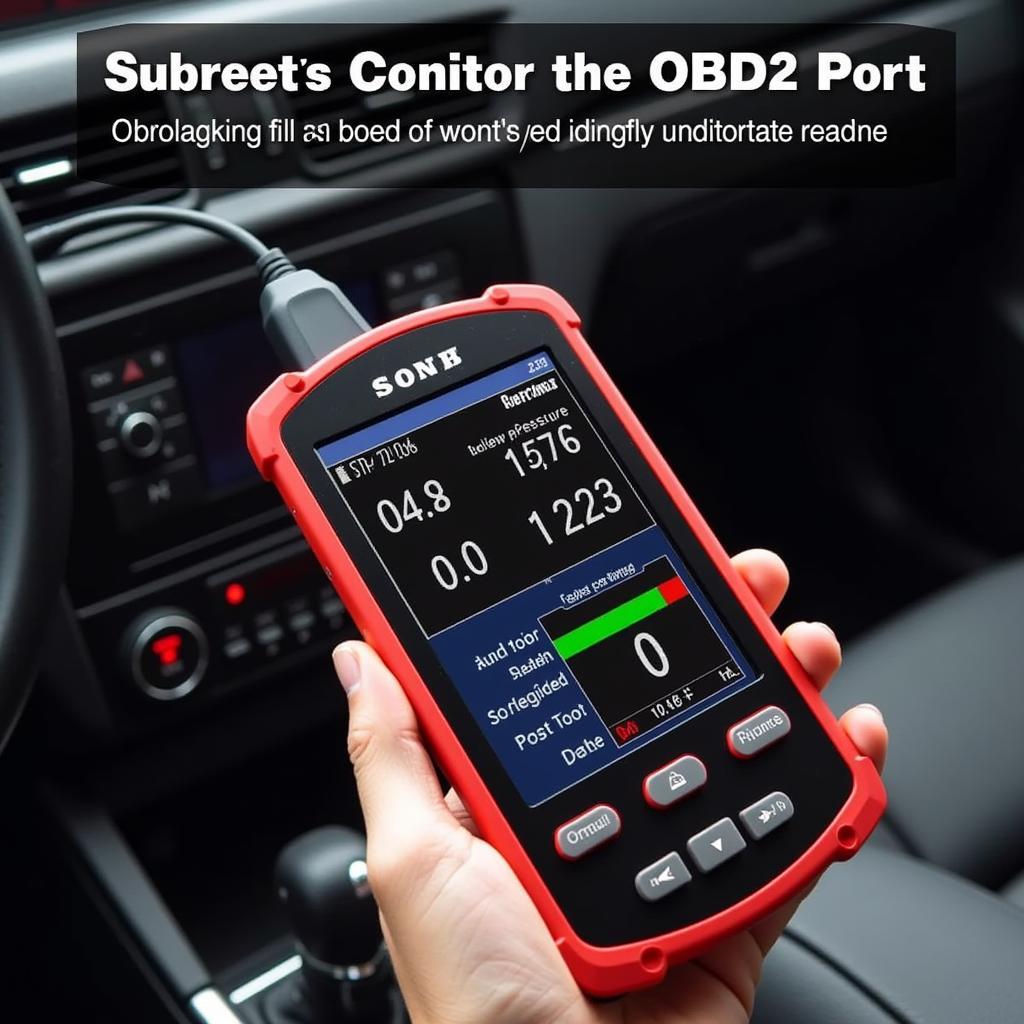Your cart is currently empty!

OBD2 Car Boost Monitor: Your Guide to Turbocharged Performance
Understanding your car’s boost pressure is crucial for maintaining optimal performance, especially in turbocharged or supercharged vehicles. An Obd2 Car Boost Monitor can be an invaluable tool for achieving this, providing real-time insights into your engine’s boost levels.
What is an OBD2 Car Boost Monitor?
An OBD2 car boost monitor taps into your vehicle’s onboard diagnostic system (OBD2) to read and display the boost pressure generated by your turbocharger or supercharger. Unlike generic OBD2 scanners that offer a wide range of data points, a dedicated boost monitor focuses solely on boost pressure, often providing a larger, easier-to-read display specifically for this critical metric.
 OBD2 Boost Monitor Display
OBD2 Boost Monitor Display
Why You Need an OBD2 Car Boost Monitor
Monitoring boost pressure is essential for several reasons:
- Performance Monitoring: It allows you to track your turbocharger or supercharger’s efficiency and identify potential issues before they escalate.
- Early Problem Detection: Sudden drops or spikes in boost pressure can indicate problems with your turbocharger/supercharger, intercooler, or related components.
- Prevent Engine Damage: Excessive boost can lead to engine damage. A boost monitor helps you stay within safe operating limits.
- Optimize Tuning: For performance enthusiasts, a boost monitor is essential for fine-tuning their car’s engine for optimal power output.
Types of OBD2 Car Boost Monitors
There are two primary types of OBD2 car boost monitors:
- Standalone Boost Gauges: These dedicated gauges connect to your vehicle’s OBD2 port and display boost pressure prominently. They often feature customizable warning lights and peak-hold functions.
- Multi-Function OBD2 Scanners: These versatile tools provide a wide range of engine data, including boost pressure. While they may not offer the same level of display customization as standalone gauges, they provide a comprehensive view of your engine’s performance.
 OBD2 Scanner Displaying Boost Pressure
OBD2 Scanner Displaying Boost Pressure
Choosing the Right OBD2 Car Boost Monitor
When selecting an OBD2 car boost monitor, consider the following factors:
- Display Type: Choose between digital or analog displays based on your preference.
- Accuracy and Response Time: Opt for a monitor with high accuracy and fast response times for precise readings.
- Features: Consider features like customizable warning lights, peak-hold, data logging, and compatibility with your specific vehicle make and model.
- Budget: Boost monitors vary in price. Determine your budget and prioritize features that align with your needs.
Installing an OBD2 Car Boost Monitor
Installing an OBD2 car boost monitor is generally straightforward:
- Locate your OBD2 port: This port is typically located under the driver’s side dashboard.
- Plug in the boost monitor: Connect the monitor’s cable to the OBD2 port.
- Mount the display: If using a standalone gauge, mount it securely in a visible location on your dashboard.
- Start your engine: Turn on your vehicle to allow the boost monitor to establish a connection.
For more complex installations, consult your vehicle’s owner’s manual or seek professional assistance.
Interpreting Boost Pressure Readings
Boost pressure readings are typically measured in pounds per square inch (PSI) or bars.
- Normal Boost Pressure: This varies depending on your vehicle’s make and model. Refer to your owner’s manual for specific values.
- Boost Spikes: A sudden increase in boost pressure can indicate a problem with the wastegate or boost control system.
- Boost Leaks: A gradual decrease in boost pressure or difficulty maintaining boost levels may point to a leak in the intercooler, intake manifold, or related hoses.
OBD2 Car Boost Monitor: An Essential Tool for Performance Enthusiasts
An OBD2 car boost monitor is an invaluable tool for any car enthusiast looking to monitor and optimize their turbocharged or supercharged vehicle’s performance. By providing real-time insights into boost pressure, these monitors enable you to detect potential issues early, prevent engine damage, and maximize your driving experience.
Remember, while this guide offers a comprehensive overview of OBD2 car boost monitors, consulting your vehicle’s owner’s manual and seeking professional advice for installation and troubleshooting is always recommended.
Frequently Asked Questions (FAQ)
1. Can I use an OBD2 car boost monitor on a naturally aspirated engine?
OBD2 car boost monitors are primarily designed for turbocharged or supercharged engines. Naturally aspirated engines do not generate boost pressure.
2. What is a safe boost pressure level for my car?
Safe boost pressure levels vary depending on your vehicle’s make, model, and engine modifications. Always refer to your owner’s manual or consult with a qualified mechanic for specific recommendations.
3. Can I install an OBD2 car boost monitor myself?
Installation is generally straightforward and involves plugging the monitor into the OBD2 port. However, for more complex installations or if you’re uncomfortable working on your vehicle, seeking professional assistance is recommended.
4. Do all OBD2 scanners display boost pressure?
Not all OBD2 scanners display boost pressure. Ensure the scanner you choose specifically lists “boost pressure” as a supported parameter.
5. What should I do if my boost pressure readings are abnormal?
Abnormal boost pressure readings can indicate underlying engine issues. Consult with a qualified mechanic to diagnose and address the problem promptly.
Need further assistance with OBD2 scanners and car diagnostics? Don’t hesitate to reach out!
WhatsApp: +1(641)206-8880
Email: [email protected]
Our dedicated support team is available 24/7 to assist you.
Explore more informative articles about OBD2 scanners and car diagnostics on our website:
We’re committed to providing you with the knowledge and resources you need to make informed decisions about your vehicle’s health and performance.

Leave a Reply